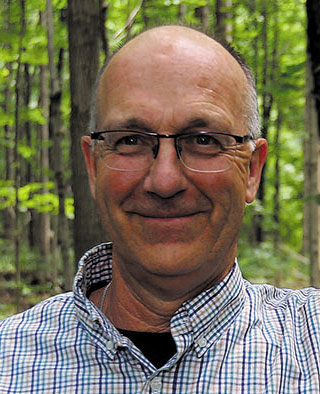Ask the Steward
Question: A number of Blue spruce trees in my windbreak are looking pretty bad. Several have dead areas with few needles that progressed quickly over summer and now have little brown cones hanging in the dead areas. Any ideas?
Answer: While Blue Spruce is not a native tree to Indiana it has been widely planted in windbreaks, yard trees and landscape screenings. It’s been a great tree, but also one with a handful or common insect and disease problems, which has caused it to fall out of favor the last several years. In your case the dead, bare branches and ‘little brown cones’ is a dead give-away that at least one major issue in your trees is ‘Bagworm’.
Bagworms are moths that feed on trees and shrubs during their larval stage, and are most frequently found on arborvitae and junipers, but are also common on Blue spruce. The 1-2” cone shaped ‘bags’ hanging from the branches are made of silk spun by the larvae together with fragments of spruce foliage. The larvae live within and carry the bags around with them as they eat the tree needles providing them camouflage and protective cover.
To control Bagworms: If possible, pick the bags from the trees and destroy them. They house the feeding larvae in the late spring and summer, and eggs laid by the female during the fall and winter. As the eggs hatch in the spring the new larvae build their own bags and the feeding cycle begins anew. If you can remove and destroy the bags, no chemical treatments are necessary. But, remain vigilant with annual inspections watching for new outbreaks.
If you are unable to remove the bags due to trees size, treatments with chemical pesticide, or biologic controls can also be effective. However, it is important to notes these treatments must be applied in accordance with label directions and during the active feeding cycle to be effective. For example, the bacteria Bacillus thuringiensis, often called Bt, must be applied in mid-June to early July while the bagworms are still young. The plus for Bt is that it is selective and only kills certain insects, including bagworm, and does not affect humans or animals. The downside is that multiple applications (2 weeks apart) may be necessary depending on local conditions. If chemical control is necessary, use only a spray specifically labelled for bagworm and your tree species. Carefully follow all label directions and treat the affected area of the tree. July is a good treatment month in Indiana as feeding slows in August. These materials can be found at a variety of garden centers and hardware stores.
Question: Several of the younger maple street trees in my town have significant split and peeling bark on one side of the tree’s trunk. What’s causing this?
Answer: This is common problem on street, yard and landscape trees and if you’ll look closer you will nearly always find this bark split on the South/Southwest side of the tree. The damage is known as ‘Sunscald’ and sometimes aptly referred to as ‘southwest injury’, which damages cells under the bark causing an elongated dead area and bark splitting. Sunscald can occur during summer months in hot climate areas as stressed cells die under the overheated bark, but here in Indiana, winter sunscald is more common.
Here’s what happens. Nice, healthy looking trees are pulled from their shaded tree nurseries where they have been cared for and watered, and get plopped down in the middle of their new home- perhaps a sun baked street tree planting berm, parking lot, or wide-open front yard. This can be pretty shocking for the tree. Watering may no longer be regular, planting technique shoddy and the shade it was accustomed to is gone. Yet for much of the year the tree tolerates and tries to adjust to its new home. Then comes the stress of winter. The bright sun warms the frozen tree and the sun’s rays intensified by reflective snow cover and light-colored surfaces. Notably, the sun rays reflect most intensely on the young tree’s south and southwest sides causing the tree bark to heat up further and cell tissues to break dormancy and become active, only to be frozen and killed by nighttime freezing temperatures. The result- sunscald.
In addition to the heating and temperature extremes noted, water stress is also a significant factor. Well hydrated trees are less likely to be damaged and is a good reason to keep newly planted trees appropriately watered during dry periods, even going into winter.
Young trees, and thin barked trees, such as Red maple and crabapple are more susceptible to sunscald. Fortunately, trees generally become more tolerant as their bark matures providing better insulation and their root systems become well established to provide needed moisture to the tree.
To treat damaged trees, carefully remove the loose peeling bark with a sharp sterilized knife or pruners. This allows the wound to dry, promotes healing and lessens the chance for insect and disease issues to form under the dead bark. In extreme cases sunscald may result in tree death, but in most cases, cared for trees will heal themselves.
An interesting side note: some tree transplanters take the time to orient transplanted trees to ensure the same side faces South as it did on the original growing site. The reason is that the bark on the natural South side of the tree is inherently thicker and better able to withstand the bright sun’s rays and hence transplant shock and sunscald issues are reduced.
Dan Ernst is a professional forester and past Assistant State Forester with the Indiana Division of Forestry. He has authored ‘Ask the Steward’ since 1992 and can be reached at foresterdan@yahoo.com

